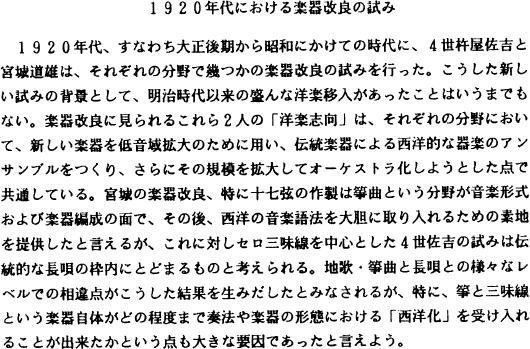Published online by Cambridge University Press: 07 March 2019
In the 1920's, approximately half a century after the Meiji Restoration,1 some genres of traditional Japanese art music,2 under the strong influence of western music,3 underwent a series of changes that in retrospect can be seen to mark an epoch-making stage in the history of Japanese traditional music. Developments within the scope of the newly born movement known as “Shin nihon ongaku” (“New Japanese music”)4 or “Shin nihon ongaku undo” (“A movement of new Japanese music”), which was led by the jiuta-sōkyoku player/composer Miyagi Michio (1894/Meiji 27—1956/Shōwa 31), can be considered as the most outstanding of these changes. It is unncessary to restate here in detail that a series of novel and somewhat daring Western-oriented attempts undertaken during the years from the 1920's to the pre-war years under the banner of Shin nihon ongaku contributed to a remarkable development of musical styles, most particularly in the genre of sōkyoku. However, in genres other than sōkyoku, it is also possible to identify a number of musicians deeply concerned with the new Western-oriented trends of Shin nihon ongaku, as well as corresponding attempts at introducing new ideas into the musical style and instruments of their own genres.5 The present paper will focus on the activities of Kineya Sakichi IV (1884/Meiji 17—1945/Shōwa 20), a nagauta shamisen player, making occasional references to Miyagi Michio. The reasons for this are: 1) although Kineya Sakichi's innovations in the genre of nagauta imply that he was a “counterpart” of Miyagi, the differences between these two figures and their achievements have not been sufficiently dealt with from a comparative viewpoint; and 2) a comparison of these musicians and their works will not only enable us to identify differences between the two personalities, but, more importantly, will also lead us to an understanding of the fundamental differences between the two genres of nagauta and sōkyoku, in terms of how these differences were reflected in the outcome of the “Westernization” of the two genres. Investigation of these differences will be made from several perspectives, such as musical styles and organological aspects, and examination will also be made of some social or paramusical conventions peculiar to each genre.
